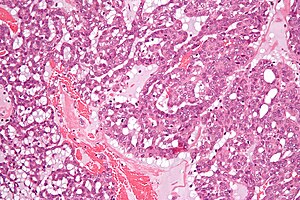Polymorphous adenocarcinoma
Jump to navigation
Jump to search
Polymorphous adenocarcinoma, abbreviated PAC, is a rare malignant salivary gland tumour.
| Polymorphous adenocarcinoma | |
|---|---|
| Diagnosis in short | |
 Polymorphous adenocarcinoma. H&E stain. | |
|
| |
| Synonyms | polymorphmous low-grade adenocarcinoma (obsolete term) |
|
| |
| LM | low-grade cytology - nuclei ovoid & small, small nucleoli, powdery chromatin (papillary thyroid carcinoma-like appearance); eosinophilic cytoplasm; variable architecture - often small nests, classically has whorling ("eye-of-storm") pattern and single file pattern |
| LM DDx | adenoid cystic carcinoma, pleomorphic adenoma, cribriform adenocarcinoma of the minor salivary gland |
| IHC | S-100 +ve, CK7 +ve, vimentin +ve |
| Site | oral cavity, salivary gland |
|
| |
| Prevalence | uncommon (varies by study) |
| Prognosis | good |
It was previously known as polymorphous low-grade adenocarcinoma, abbreviated PLGA.[1]
General
Gross
- Tumour of the minor salivary glands.[5]
- Almost exclusively in the oral cavity - usually palate.[3]
Microscopic
Features:[6]
- Architecture: often small nests, may be targetoid.
- Classically has whorling with eye-of-storm & single file.
- Cytologically monotonous (uniform) with variable architecture - key feature.
- Nucleus: ovoid & small, small nucleoli, powdery chromatin.
- Papillary thyroid carcinoma-like appearance.
- Cytoplasm: eosinophilic.
- Nucleus: ovoid & small, small nucleoli, powdery chromatin.
- Indistinct cell borders.
Note:
- Always a low-grade tumour - by definition.
DDx:
- Adenoid cystic carcinoma.
- Pleomorphic adenoma.
- Cribriform adenocarcinoma of the minor salivary gland.[7]
Images
IHC
Features:[2]
- S-100 +ve.
- CK7 +ve.
- Vimentin +ve.
Others:
- GFAP +ve/-ve.
- One study suggests GFAP cleanly separates the PLGA (-ve) from pleomorphic adenoma (+ve).[8]
- BCL2 +ve/-ve.
- Generally negative for myoepithelial markers (calponin, actin) - useful if negative.
See also
References
- ↑ "Polymorphous adenocarcinoma of the salivary glands: reappraisal and update". Eur Arch Otorhinolaryngol 275 (7): 1681–1695. July 2018. doi:10.1007/s00405-018-4985-5. PMID 29761209.
- ↑ 2.0 2.1 de Araujo, VC.; Passador-Santos, F.; Turssi, C.; Soares, AB.; de Araujo, NS. (2013). "Polymorphous low-grade adenocarcinoma: an analysis of epidemiological studies and hints for pathologists.". Diagn Pathol 8: 6. doi:10.1186/1746-1596-8-6. PMID 23320410.
- ↑ 3.0 3.1 Paleri, V.; Robinson, M.; Bradley, P. (Apr 2008). "Polymorphous low-grade adenocarcinoma of the head and neck.". Curr Opin Otolaryngol Head Neck Surg 16 (2): 163-9. doi:10.1097/MOO.0b013e3282f70441. PMID 18327037.
- ↑ Fife, TA.; Smith, B.; Sullivan, CA.; Browne, JD.; Waltonen, JD.. "Polymorphous low-grade adenocarcinoma: a 17 patient case series.". Am J Otolaryngol 34 (5): 445-8. doi:10.1016/j.amjoto.2013.03.012. PMID 23618791.
- ↑ Andreu-Barasoain, M.; Vicente-Martín, FJ.; Gómez de la Fuente, E.; Salamanca-Santamaría, J.; Pampín-Franco, A.; López-Estebaranz, JL. (2013). "Polymorphous low-grade adenocarcinoma in the upper lip: a well-described but infrequently recognized tumor.". Dermatol Online J 19 (8): 19265. PMID 24021444.
- ↑ Humphrey, Peter A; Dehner, Louis P; Pfeifer, John D (2008). The Washington Manual of Surgical Pathology (1st ed.). Lippincott Williams & Wilkins. pp. 74. ISBN 978-0781765275.
- ↑ Skalova, A.; Sima, R.; Kaspirkova-Nemcova, J.; Simpson, RH.; Elmberger, G.; Leivo, I.; Di Palma, S.; Jirasek, T. et al. (Aug 2011). "Cribriform adenocarcinoma of minor salivary gland origin principally affecting the tongue: characterization of new entity.". Am J Surg Pathol 35 (8): 1168-76. doi:10.1097/PAS.0b013e31821e1f54. PMID 21716087.
- ↑ Curran, AE.; White, DK.; Damm, DD.; Murrah, VA. (Feb 2001). "Polymorphous low-grade adenocarcinoma versus pleomorphic adenoma of minor salivary glands: resolution of a diagnostic dilemma by immunohistochemical analysis with glial fibrillary acidic protein.". Oral Surg Oral Med Oral Pathol Oral Radiol Endod 91 (2): 194-9. doi:10.1067/moe.2001.111306. PMID 11174597.